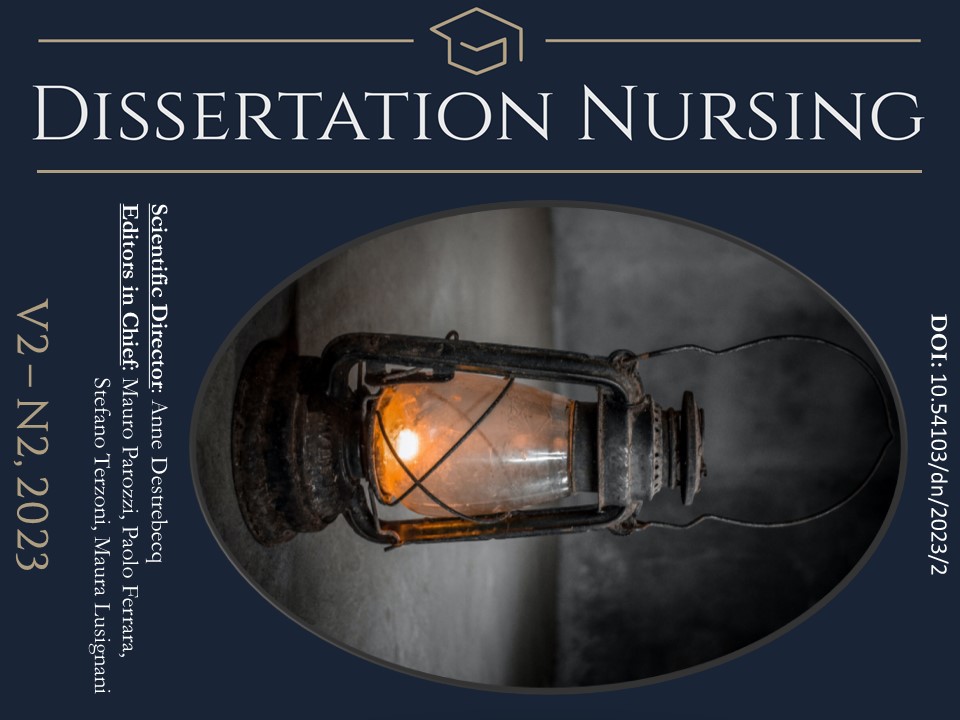Sleep disorders in Italian nursing students: a pilot study.
DOI:
https://doi.org/10.54103/dn/20574Keywords:
Sleep disorders, nursing students, academic performanceAbstract
BACKGROUND: The nursing profession is particularly susceptible to sleep disturbances due to altered circadian rhythms, frequent changes in shift patterns, and overtime work, resulting in fewer hours devoted to sleep and an increased risk of errors in care. Sleep disorders, however, seem to start as early as during undergraduate training: in fact, it has been found that the high teaching load and the sudden alternation between theory, exams, and internship can be a source of stress and anxiety, leading to these kinds of disorders even during basic training. This study, therefore, set out to investigate the incidence of sleep disorders and examine the factors associated with them among nursing students in Italy.
METHODS: A cross-sectional web-based study was conducted from January to August 2022, administering the Italian version of the Pittsburgh Sleep Quality Index (PSQI) was administered. The normality of the distribution was assessed using the Kolmogorov-Smirnov test. A binary logistic regression analysis was performed.
RESULTS: The survey was completed by 4898 students. The Kolmogorov-Smirnov test stated that the scores followed a normal distribution. The logistic regression found that being female, suffering from a disease, being a working student, regularly consuming tea or alcohol, and perceiving that sleep disorders impact academic performance are factors influencing the occurrence of sleep disorders.
CONCLUSIONS: Our results suggest nurse educators to implement strategies to facilitate the path of nursing students and reduce the risk of errors in nursing. Official studies of individual universities should confirm this pilot study's results.
References
K. Pavlova M, Latreille V. Sleep Disorders. The American Journal of Medicine. 2019 Mar;132(3):292–9.
Sateia MJ. International Classification of Sleep Disorders-Third Edition. Chest. 2014 Nov;146(5):1387–94.
Olesen J, Gustavsson A, Svensson M, Wittchen HU, Jönsson B, on behalf of the CDBE2010 study group, et al. The economic cost of brain disorders in Europe: Economic cost of brain disorders in Europe. European Journal of Neurology. 2012 Jan;19(1):155–62.
Sleep Disorders and Sleep Deprivation: An Unmet Public Health Problem [Internet]. Washington, D.C.: National Academies Press; 2006 [cited 2023 Jul 7]. Available from: http://www.nap.edu/catalog/11617
Di Muzio M, Diella G, Di Simone E, Pazzaglia M, Alfonsi V, Novelli L, et al. Comparison of Sleep and Attention Metrics Among Nurses Working Shifts on a Forward- vs Backward-Rotating Schedule. JAMA Netw Open. 2021 Oct 18;4(10):e2129906.
Huang CLC, Wu MP, Ho CH, Wang JJ. Risks of treated anxiety, depression, and insomnia among nurses: A nationwide longitudinal cohort study. Alameddine M, editor. PLoS ONE. 2018 Sep 25;13(9):e0204224.
Yazdanshenas Ghazwin M, Kavian M, Ahmadloo M, Jarchi A, Golchin Javadi S, Latifi S, et al. The Association between Life Satisfaction and the Extent of Depression, Anxiety and Stress among Iranian Nurses: A Multicenter Survey. Iran J Psychiatry. 2016 Apr;11(2):120–7.
Hsieh ML, Li YM, Chang ET, Lai HL, Wang WH, Wang SC. Sleep disorder in Taiwanese nurses: A random sample survey: Sleep survey and nurses. Nursing & Health Sciences. 2011 Dec;13(4):468–74.
Silva RM da, Costa ALS, Mussi FC, Lopes VC, Batista K de M, Santos OP dos. Health alterations in nursing students after a year from admission to the undergraduate course. Rev esc enferm USP. 2019;53:e03450.
Membrive-Jiménez MJ, Gómez-Urquiza JL, Suleiman-Martos N, Velando-Soriano A, Ariza T, De la Fuente-Solana EI, et al. Relation between Burnout and Sleep Problems in Nurses: A Systematic Review with Meta-Analysis. Healthcare. 2022 May 21;10(5):954.
Geiger-Brown J, Rogers VE, Trinkoff AM, Kane RL, Bausell RB, Scharf SM. Sleep, Sleepiness, Fatigue, and Performance of 12-Hour-Shift Nurses. Chronobiology International. 2012 Mar;29(2):211–9.
Kemper KJ, Mo X, Khayat R. Are Mindfulness and Self-Compassion Associated with Sleep and Resilience in Health Professionals? The Journal of Alternative and Complementary Medicine. 2015 Aug;21(8):496–503.
d’Ettorre G, Pellicani V, Caroli A, Greco M. Shift work sleep disorder and job stress in shift nurses: implications for preventive interventions. La Medicina del Lavoro | Work, Environment and Health. 2020 Jun 26;111(3):195–202.
Eanes L. CE: The Potential Effects of Sleep Loss on a Nurse’s Health. AJN, American Journal of Nursing. 2015 Apr;115(4):34–40.
Gallego-Gómez JI, González-Moro MTR, González-Moro JMR, Vera-Catalán T, Balanza S, Simonelli-Muñoz AJ, et al. Relationship between sleep habits and academic performance in university Nursing students. BMC Nurs. 2021 Dec;20(1):100.
Marta OFD, Kuo SY, Bloomfield J, Lee HC, Ruhyanudin F, Poynor MY, et al. Gender differences in the relationships between sleep disturbances and academic performance among nursing students: A cross-sectional study. Nurse Education Today. 2020 Feb;85:104270.
Belingheri M, Pellegrini A, Facchetti R, De Vito G, Cesana G, Riva MA. Self-reported prevalence of sleep disorders among medical and nursing students. Occupational Medicine. 2020 Apr 20;70(2):127–30.
Salvi CPP, Mendes SS, Martino MMFD. Profile of nursing students: quality of life, sleep and eating habits. Rev Bras Enferm. 2020;73(suppl 1):e20190365.
Demi̇R G. Daytime sleepiness and related factors in nursing students. Nurse Education Today. 2017 Dec;59:21–5.
Najafi Kalyani M, Jamshidi N, Salami J, Pourjam E. Investigation of the Relationship between Psychological Variables and Sleep Quality in Students of Medical Sciences. Depression Research and Treatment. 2017;2017:1–6.
Gianfredi V, Nucci D, Tonzani A, Amodeo R, Benvenuti AL, Villarini M, et al. Sleep disorder, Mediterranean Diet and learning performance among nursing students: inSOMNIA, a cross-sectional study. Ann Ig. 2018;30(6):470–81.
Fernández-Medina IM, Ruíz-Fernández MD, Hernández-Padilla JM, Granero-Molina J, Fernández-Sola C, Jiménez-Lasserrotte M del M, et al. Adherence to the Mediterranean Diet and Self-efficacy as Mediators in the Mediation of Sleep Quality and Grades in Nursing Students. Nutrients. 2020 Oct 25;12(11):3265.
Angelone AM, Mattei A, Sbarbati M, Di Orio F. Prevalence and correlates for self-reported sleep problems among nursing students. J Prev Med Hyg. 2011 Dec;52(4):201–8.
Kayaba M, Matsushita T, Katayama N, Inoue Y, Sasai-Sakuma T. Sleep–wake rhythm and its association with lifestyle, health-related quality of life and academic performance among Japanese nursing students: a cross-sectional study. BMC Nurs. 2021 Dec;20(1):225.
Asta ML, Lo Presti S, Pasetti P, Bonazza V. Il legame tra la privazione del sonno e gli errori commessi dagli infermieri durante il turno di notte. PROFINF. 2022 Oct 23;75(2):101–5.
Tang Z, Li X, Zhang Y, Li X, Zhang X, Hu M, et al. Psychometric analysis of a Chinese version of the Sleep Hygiene Index in nursing students in China: a cross-sectional study. Sleep Medicine. 2021 May;81:253–60.
Li SH, Graham BM. Why are women so vulnerable to anxiety, trauma-related and stress-related disorders? The potential role of sex hormones. The Lancet Psychiatry. 2017 Jan;4(1):73–82.
Amaral KV, Galdino MJQ, Martins JT. Sleep quality and work among nursing vocational students. Rev Bras Enferm. 2021;74(6):e20201285.
Ferreira LRC, Martino MMFD. Padrão de sono e sonolência do trabalhador estudante de enfermagem. Rev esc enferm USP. 2012 Oct;46(5):1178–83.
Koob GF, Colrain IM. Alcohol use disorder and sleep disturbances: a feed-forward allostatic framework. Neuropsychopharmacol. 2020 Jan;45(1):141–65.
Terry D, Peck B. Academic and clinical performance among nursing students: What’s grit go to do with it? Nurse Education Today. 2020 May;88:104371.
Downloads
Published
How to Cite
Issue
Section
License
Copyright (c) 2023 Celeste Granziero, Giorgio Bergesio, Bartolomeo Rinaldi, Ilaria Marcomini

This work is licensed under a Creative Commons Attribution-NonCommercial-NoDerivatives 4.0 International License.
Accepted 2023-07-28
Published 2023-07-31











